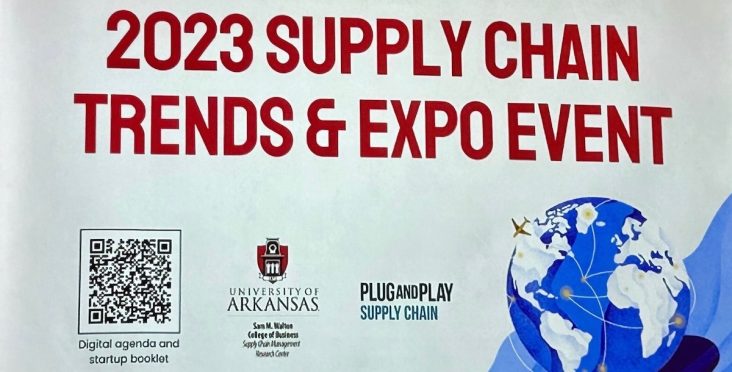Supply chain leaders and innovators gather at Plug & Play event in Bentonville
by April 19, 2023 5:17 pm 1,398 views

More than 200 people who work in the retail supply chain gathered in Bentonville on Wednesday (April 19) for the 2023 Supply Chain Trends and Expo event to discuss the biggest problems and opportunities around managing inventory.
The event was co-sponsored by the University of Arkansas and Plug and Play, who are jointly invested in developing and supporting supply chain talent to help solve ongoing problems in the industry.
Plug and Play CEO and founder Saeed Amidi and former Arkansas Gov. Asa Hutchinson opened the event with each offering their appreciation via video statements to Matt Waller, the Sam M. Walton College of Business Dean and long-time supply chain professor at the University of Arkansas, for his dedication to supply chain education and developing partnership between industry, academia and innovators for a more connected supply chain ecosystem across the region and the globe.
Waller is returning to the classroom this fall and stepping away from the dean position he held for 8 years. Chris Sultemeier, former head of Walmart Transportation and now the operating partner at NewRoad Capital Partners in Rogers, announced an annual award to be given in Waller’s honor to a person or team exhibiting excellence in supply chain leadership and/or innovation. The inaugural Matt Waller Innovation Award was given to Charu Thomas, founder of Ox, a software startup that uses wearable technology to direct frontline workers. The Bentonville-based startup was founded in 2019 and now employs 40.
Waller and Brent Williams, recently named interim dean at the Walton College of Business, also spoke at the event. Waller said supplier teams in Northwest Arkansas that serve Walmart and retail have largely not restructured to follow Walmart’s lead. He said Walmart merged its merchant team for online and in-store more than two years ago, and it is necessary for business merchants to be able to see the entire business. He said siloing the online and in-store divisions no longer makes sense as demands from consumers continue to push retailers to have the products they want to buy when, where and how they want to shop.

Williams said the pandemic brought to the light the complexity and also inefficiencies of retail supply chains. When they are running well, no one notices, but when consumers couldn’t get what they needed and wanted, suddenly supply chain workers became the most popular people in a room. He said while the pandemic has passed, there is still pressure on the supply chain, and businesses are also left with 3 years of sales data that is of no use when trying to predict future demand.
Williams said local supplier teams would need to see more integration in order to keep up with the speed of omnichannel. He said customers don’t care why the product is out of stock, and the onus is on retailers and their supplier partners to ensure inventory is where it needs to be at all times.
Williams was asked how pandemic lessons could impact demand forecasting in the future. He said building a supply chain to handle risks as big as those brought on by the pandemic is not sustainable. What retailers and their supplier partners must do is do a better job of building in some risks and also seek to use the data from multiple sources simultaneously.
“The speed of [omnichannel] makes using historical data more challenging to use predictively at the store level,” Williams said.
Karisa Sprague, executive vice president of distribution fulfillment at Walmart U.S., said Walmart continues to invest heavily in supply chain innovation. She highlighted four next-generation high-speed fulfillment centers that Walmart is building to get more products close to the end users. The first center opened in Joliet, Ill., and has been able to double the number of orders filed in a day because of its automated operation. Walmart worked with fulfillment tech company Knapp to develop what is described as “an automated, high-density storage system that streamlines a manual, twelve-step process into just five steps.”
A panel that included supply chain execs from Procter & Gamble, RJW Logistics and Fort Smith-based ArcBest discussed other issues with demand planning for the omnichannel shopper. A big issue discussed was the four hours of time wasted by drivers waiting each day to deliver and pick up at retailers and their own manufacturing plants. Cory Knox, vice president of supply chain operations at P&G, said P&G developed software to automate driver delivery schedules. He said on-time delivery is 98% because time has been optimized.
Jennifer Shorkey, head of partnerships at RJW, who spent more than two decades at Walmart Transportation, said the scheduling issue is a problem for retailers as they often schedule labor based on delivery times. She said the industry still does not have 100% visibility end-to-end of the supply chain.
John Joyce, director of enterprise development at ArcBest, said for too long, the supply chain industry has applied Bandaids instead of really looking to solve problems. In a post-COVID world, he said the firefighter mentality wouldn’t be enough as customer demands continue to rise. He said there is more innovation for the supply chain coming to the market and being developed in-house. All three execs said omnichannel is requiring a more digital supply chain, end to end.
“The way we think about holding on to shelf space at retail is radically different. Ultimately we think shelf space will be decided for us,” Knox said. “It’s omni today. What is the right way to serve customers in stores and online? We have to streamline our portfolio to serve all customers. Where and how I hold and move my inventory is key to my being able to serve consumers.”
